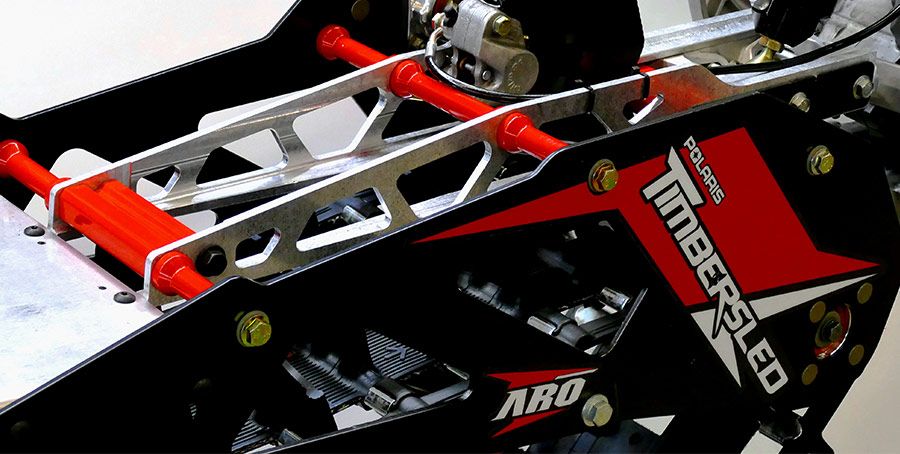My cobuilder Jonas has fixed his sprocket failure in the outer chain transmission. The sprocket came off the shaft. This was the only sprocket on the drive train that we tested to weld directly on to the shaft, which obviously was a bad idea. With this insight, we will onward mount all sprockets with either a keyways or flange bolts. Keyways has worked flawlessly on our previous builds. Splines are of course the best solution but not easy to machine for the home builder.

The failure probably started with micro cracks in the weld caused by vibrations or impact stresses from stallings or similar. The weld could certainly have been better executed, but none of us are qualified licensed welders. Possibly the difference in material properties between sprocket and shaft that at the end made a poor weld. Differeces in alloys, hardening etc. makes welding more difficult. Pre heating and type of filler material is something we do not have knowledge of, but are certainly important for a strong weld as in this aplication.
Our prevuios builds has shown that a 20 mm key will easily take the stress despite a powerful turbo bike and a long tall lug track that hooks up strongly.


We feel that the gearbox is completely different on the 2017 KTM500 compared to the 2016 500.
1:st-5:th has a more close ratio while 6:th jumps up quite much.
Honestly, I like the gearbox ratios on the 2016 better. The 2017 will work good as a standard naturally aspirated, but with the turbocharger it can easily pick up power with greater speed differences between gears. I rather like to have larger jumps between gears instead of constantly hitting the revlimiter shortly after each gear shift.
To increase the speed difference between the gears and considering the 6th gear as more or less useless overdrive, we tested to gear up from 16 to 17 teeth on the jack shaft in the outer transmision.
The gearing was felt clearly better but we want to increase gearing further.
Ordered a 18 tooth sprocket and machined it with keyway slot ready to go on. When I tried to assemble everything, the chain was obviously short. This idea was a complete miss and all work gone in the scrap bin.
Have ordered a 15 tooth engine sprocket. Currently running 14 teeth. 15 tooth should provide an equivalent ratio increase. In addition, the chain will have greater clearance around the swing arm bearing which will be an improvement.

Mounted a Koso Stage 6 muliti guage with tachometer, hourmeter, speedometer and temperature gauge.
The temperature sensor is inserted in an intermediate aluminum tube piece on the hose from the head.
Cut the hose and machined a hose joint with the same overall dimensions as the temp probe piece to the corresponding part of the U-hose.
Was not satisfied because the hose bend ended up to be too tight that the hose had a slight crease. Ordered a new aftermarket 19 mm U-hose. A better result as I could go directly from the probe piece to the thermostat housing.


The failure probably started with micro cracks in the weld caused by vibrations or impact stresses from stallings or similar. The weld could certainly have been better executed, but none of us are qualified licensed welders. Possibly the difference in material properties between sprocket and shaft that at the end made a poor weld. Differeces in alloys, hardening etc. makes welding more difficult. Pre heating and type of filler material is something we do not have knowledge of, but are certainly important for a strong weld as in this aplication.
Our prevuios builds has shown that a 20 mm key will easily take the stress despite a powerful turbo bike and a long tall lug track that hooks up strongly.


We feel that the gearbox is completely different on the 2017 KTM500 compared to the 2016 500.
1:st-5:th has a more close ratio while 6:th jumps up quite much.
Honestly, I like the gearbox ratios on the 2016 better. The 2017 will work good as a standard naturally aspirated, but with the turbocharger it can easily pick up power with greater speed differences between gears. I rather like to have larger jumps between gears instead of constantly hitting the revlimiter shortly after each gear shift.
To increase the speed difference between the gears and considering the 6th gear as more or less useless overdrive, we tested to gear up from 16 to 17 teeth on the jack shaft in the outer transmision.
The gearing was felt clearly better but we want to increase gearing further.
Ordered a 18 tooth sprocket and machined it with keyway slot ready to go on. When I tried to assemble everything, the chain was obviously short. This idea was a complete miss and all work gone in the scrap bin.
Have ordered a 15 tooth engine sprocket. Currently running 14 teeth. 15 tooth should provide an equivalent ratio increase. In addition, the chain will have greater clearance around the swing arm bearing which will be an improvement.

Mounted a Koso Stage 6 muliti guage with tachometer, hourmeter, speedometer and temperature gauge.
The temperature sensor is inserted in an intermediate aluminum tube piece on the hose from the head.
Cut the hose and machined a hose joint with the same overall dimensions as the temp probe piece to the corresponding part of the U-hose.
Was not satisfied because the hose bend ended up to be too tight that the hose had a slight crease. Ordered a new aftermarket 19 mm U-hose. A better result as I could go directly from the probe piece to the thermostat housing.







































